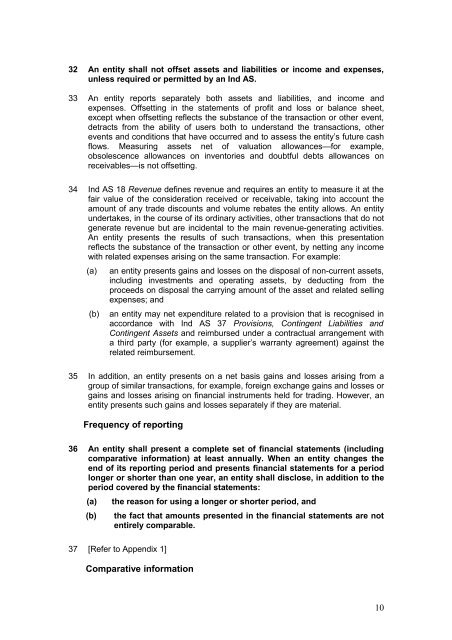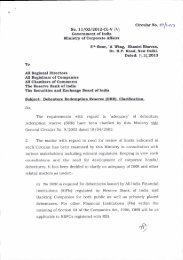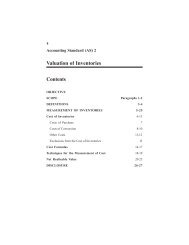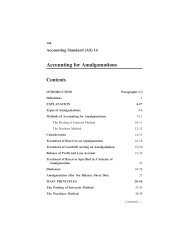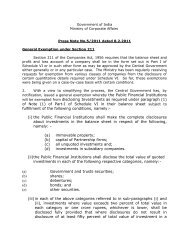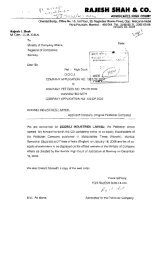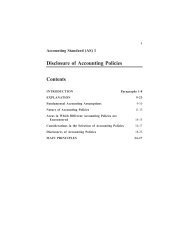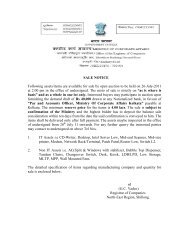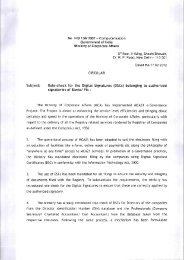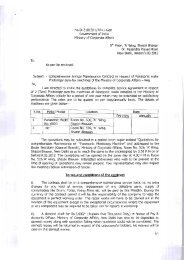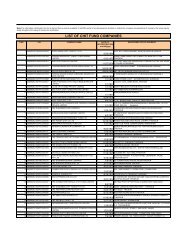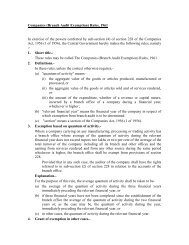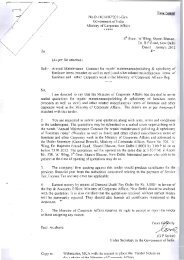Indian Accounting Standards(Ind AS) 1
Indian Accounting Standards(Ind AS) 1
Indian Accounting Standards(Ind AS) 1
You also want an ePaper? Increase the reach of your titles
YUMPU automatically turns print PDFs into web optimized ePapers that Google loves.
32 An entity shall not offset assets and liabilities or income and expenses,<br />
unless required or permitted by an <strong>Ind</strong> <strong>AS</strong>.<br />
33 An entity reports separately both assets and liabilities, and income and<br />
expenses. Offsetting in the statements of profit and loss or balance sheet,<br />
except when offsetting reflects the substance of the transaction or other event,<br />
detracts from the ability of users both to understand the transactions, other<br />
events and conditions that have occurred and to assess the entity’s future cash<br />
flows. Measuring assets net of valuation allowances—for example,<br />
obsolescence allowances on inventories and doubtful debts allowances on<br />
receivables—is not offsetting.<br />
34 <strong>Ind</strong> <strong>AS</strong> 18 Revenue defines revenue and requires an entity to measure it at the<br />
fair value of the consideration received or receivable, taking into account the<br />
amount of any trade discounts and volume rebates the entity allows. An entity<br />
undertakes, in the course of its ordinary activities, other transactions that do not<br />
generate revenue but are incidental to the main revenue-generating activities.<br />
An entity presents the results of such transactions, when this presentation<br />
reflects the substance of the transaction or other event, by netting any income<br />
with related expenses arising on the same transaction. For example:<br />
(a) an entity presents gains and losses on the disposal of non-current assets,<br />
including investments and operating assets, by deducting from the<br />
proceeds on disposal the carrying amount of the asset and related selling<br />
expenses; and<br />
(b) an entity may net expenditure related to a provision that is recognised in<br />
accordance with <strong>Ind</strong> <strong>AS</strong> 37 Provisions, Contingent Liabilities and<br />
Contingent Assets and reimbursed under a contractual arrangement with<br />
a third party (for example, a supplier’s warranty agreement) against the<br />
related reimbursement.<br />
35 In addition, an entity presents on a net basis gains and losses arising from a<br />
group of similar transactions, for example, foreign exchange gains and losses or<br />
gains and losses arising on financial instruments held for trading. However, an<br />
entity presents such gains and losses separately if they are material.<br />
Frequency of reporting<br />
36 An entity shall present a complete set of financial statements (including<br />
comparative information) at least annually. When an entity changes the<br />
end of its reporting period and presents financial statements for a period<br />
longer or shorter than one year, an entity shall disclose, in addition to the<br />
period covered by the financial statements:<br />
(a) the reason for using a longer or shorter period, and<br />
(b) the fact that amounts presented in the financial statements are not<br />
entirely comparable.<br />
37 [Refer to Appendix 1]<br />
Comparative information<br />
10


